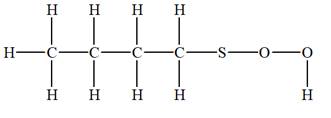
Concept explainers
(a)
Interpretation:
IHD for the compound having the molecular formula
Concept introduction:
In order to determine the IHD of a given molecular formula, first draw any saturated molecule that has the same number of each non-hydrogen atom as in the given formula. The general formula of a saturated hydrocarbon is
Answer to Problem 4.49P
IHD for the compound having molecular formula
Explanation of Solution
The given molecular formula is
Thus, this saturated molecule has 8 additional hydrogen atoms as compared to the given molecular formula. IHD for the given molecular formula is calculated by dividing that number of additional hydrogen atoms by 2. Thus, IHD is
The IHD for the compound with a given molecular formula is calculated by applying the steps above.
(b)
Interpretation:
IHD for the compound having the molecular formula
Concept introduction:
In order to determine the IHD of a given molecular formula, first draw any saturated molecule that has the same number of each non-hydrogen atom as in the given formula. The general formula of a saturated hydrocarbon is
Answer to Problem 4.49P
IHD for the compound having molecular formula
Explanation of Solution
The given molecular formula is

It takes a total of 15 hydrogen atoms to saturate each carbon, nitrogen, and oxygen in this compound. Thus, this saturated molecule has 10 additional hydrogen atoms as compared to the given molecular formula. IHD for the given molecular formula is calculated by dividing that number of additional hydrogen atoms by 2. Thus IHD is
The IHD for the compound with a given molecular formula is calculated by applying the steps above.
(c)
Interpretation:
IHD for the compound having the molecular formula
Concept introduction:
In order to determine the IHD of a given molecular formula, first draw any saturated molecule that has the same number of each non-hydrogen atom as in the given formula. The general formula of a saturated hydrocarbon is
Answer to Problem 4.49P
IHD for the compound having molecular formula
Explanation of Solution
The given molecular formula is

It takes a total of
The IHD for the compound with a given molecular formula is calculated by applying the steps above.
(d)
Interpretation:
IHD for the compound having the molecular formula
Concept introduction:
In order to determine the IHD of a given molecular formula, first draw any saturated molecule that has the same number of each non-hydrogen atom as in the given formula. The general formula of a saturated hydrocarbon is
Answer to Problem 4.49P
IHD for the compound having molecular formula
Explanation of Solution
The given molecular formula is

It takes a total of
The IHD for the compound with a given molecular formula is calculated by applying the steps above.
(f)
Interpretation:
IHD for the compound having the molecular formula
Concept introduction:
In order to determine the IHD of a given molecular formula, first draw any saturated molecule that has the same number of each non-hydrogen atom as in the given formula. The general formula of a saturated hydrocarbon is
Answer to Problem 4.49P
IHD for the compound having molecular formula
Explanation of Solution
The given molecular formula is

It takes a total of
The IHD for the compound with a given molecular formula is calculated by applying the steps above.
Want to see more full solutions like this?
Chapter 4 Solutions
Organic Chemistry: Principles and Mechanisms (Second Edition)
- Show the mechanism steps to obtain the lowerenergy intermediate: *see imagearrow_forwardSoap is made by the previous reaction *see image. The main difference between one soap and another soap isthe length (number of carbons) of the carboxylic acid. However, if a soap irritates your skin, they mostlikely used too much lye.Detergents have the same chemical structure as soaps except for the functional group. Detergentshave sulfate (R-SO4H) and phosphate (R-PO4H2) functional groups. Draw the above carboxylic acidcarbon chain but as the two variants of detergents. *see imagearrow_forwardWhat are the reactions or reagents used? *see imagearrow_forward
- The two pKa values of oxalic acid are 1.25 and 3.81. Why are they not the same value? Show the protontransfer as part of your explanation. *see imagearrow_forwardасть Identify all the bonds that gauche interact with C-OMe in the most stable conformation of the above compound.arrow_forwardPredict the reactants used in the formation of the following compounds using Acid-Catalyzed dehydration reactionarrow_forward
- Can I please get help with this?arrow_forward.. Give the major organic product(s) for each of the following reactions or sequences of reactions. Show ll relevant stereochemistry [3 ONLY]. A H Br 1. NaCN 2 NaOH, H₂O, heat 3. H3O+ B. CH₂COOH 19000 1. LiAlH4 THF, heat 2 H₂O* C. CH Br 1. NaCN, acetone 2 H3O+, heat D. Br 1. Mg. ether 3. H₂O+ 2 CO₂ E. CN 1. (CH) CHMgBr, ether 2 H₂O+arrow_forwardAssign this COSY spectrumarrow_forward
 Chemistry: The Molecular ScienceChemistryISBN:9781285199047Author:John W. Moore, Conrad L. StanitskiPublisher:Cengage Learning
Chemistry: The Molecular ScienceChemistryISBN:9781285199047Author:John W. Moore, Conrad L. StanitskiPublisher:Cengage Learning Introduction to General, Organic and BiochemistryChemistryISBN:9781285869759Author:Frederick A. Bettelheim, William H. Brown, Mary K. Campbell, Shawn O. Farrell, Omar TorresPublisher:Cengage Learning
Introduction to General, Organic and BiochemistryChemistryISBN:9781285869759Author:Frederick A. Bettelheim, William H. Brown, Mary K. Campbell, Shawn O. Farrell, Omar TorresPublisher:Cengage Learning General, Organic, and Biological ChemistryChemistryISBN:9781285853918Author:H. Stephen StokerPublisher:Cengage Learning
General, Organic, and Biological ChemistryChemistryISBN:9781285853918Author:H. Stephen StokerPublisher:Cengage Learning Organic ChemistryChemistryISBN:9781305580350Author:William H. Brown, Brent L. Iverson, Eric Anslyn, Christopher S. FootePublisher:Cengage Learning
Organic ChemistryChemistryISBN:9781305580350Author:William H. Brown, Brent L. Iverson, Eric Anslyn, Christopher S. FootePublisher:Cengage Learning



